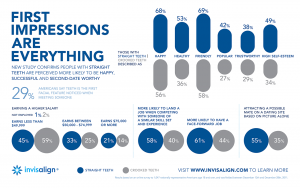By Ray Williams, February 11, 2019
Remember that famous line in the movie Jerry Maguire where Renee Zellweger says to Tom Cruise, “You had me at ‘hello’ “? Or how participants in a speed dating exercise almost instantly assess the likeability of a successful date or relationship? Or executives interviewing candidates for a job claiming they had decided who to choose in the first few minutes of the interview?
First impressions are important, and surprisingly accurate, and yet can also contain a healthy dose both of bias and misperception.
Some History
First impressions are integral to human interactions, and philosophers and scientists have long discussed the idea that the face is a window into our internal traits. Explanations for this phenomenon include the attractiveness stereotype, self-fulfilling prophecies, or “good genes” hypotheses from evolutionary psychology, but there have been mixed findings regarding the accuracy of such judgments.
People make subjective judgments about others on a regular basis, consciously and subconsciously. But how much information can actually be gleaned from a glance at a face? The idea that internal traits can be displayed externally dates back at least to Aristotle, who states, “It is possible to infer character from features”. In the late 1700’s, Johann Kaspar Lavater, a Swiss pastor, published a series of essays on this ideal – known as physiognomy – which gained a great following into the 19thcentury. The shape of the nose, the set of the jaw, the width of the forehead – all were key to understanding whether a person would be well-suited to a particular occupation because those physical traits were directly linked to intelligence, or kindness, or perseverance. Such judgments are based on stable traits and facial characteristics, not on fleeting expressions, emotions, or interactions.
In Darwin’s time, physiognomy was accepted as fact, and he refers to it throughout his journal in relation to native peoples he met on his travels. Darwin ran into trouble himself though, when applying to be the “adventurous young man” accompanying Captain Fitz-Roy on the HMS Beagle. “Afterwards… I heard that I had run a very narrow risk of being rejected, on account of the shape of my nose! He was an ardent disciple of Lavater, and was convinced that he could judge of a man’s character by the outline of his features; and he doubted whether anyone with my nose could possess sufficient energy and determination for the voyage. But I think he was afterwards well satisfied that my nose had spoken falsely.”.
Physiognomy fell out of favor in the late 19thCentury due to its association with Phrenology – the notion that one’s personality could be found by reading the bumps on his or her skull, which represented certain areas of the brain being larger or smaller. Upon opening the skull, scientists discovered that the inside of the skull is smooth – so bumps could not possibly represent areas of the brain – and thus phrenology was discredited, and it’s cousin physiognomy along with it.

What the Research Says
So what doe more recent research say that could help us assess whether first impressions are valid and reliable.?
- According to a study led by Jeremy Biesanz of the University of British Columbia, in Social Psychological and Personality Science. He noted that there are two ways to be right about people’s personality. We can know how people are different from each other, but a good judge of persons knows that people are mostly alike — for example, almost everyone would prefer being friendly to being quarrelsome. The more people rated their partner’s personality in a way typical of most everyone, the more accurate they felt their perception was.
- Any information about a person, from her physical properties to her nonverbal and verbal behaviors, and even the environment she inhabits, influences our impressions and judgments about her (e.g., Ambady & Rosenthal, 1993; Gosling, Ko, Mannarell, & Morris, 2002). First impressions have been shown to last for months (Gunaydin, Selcuk, & Zayas, 2017) and affect personal judgments even in the presence of contradictory evidence about the individual (e.g., Rydell & McConnell, 2006).

- A study from researchers at the University of York reveals just how quickly we form these first impressions.“Facial impressions are relevant given that these occur very briefly (in as little as 33 milliseconds) and they are consequential, for instance, predicting government election results and influencing romantic preferences,” explained study author Jennifer K. South Palomares.The researchers found evidence that a single glance of a person’s face for just 33 to 100 milliseconds was sufficient to form a first impression. The study, published in Social Psychological and Personality Science. The findings are particularly relevant nowadays, thanks to dating apps like Tinder that rely on first impressions. “We examined people’s first impressions of faces on three traits fundamental in the partner preference literature: trustworthiness, status, and attractiveness,” Palomares said. “An essential next step involves asking participants to evaluate faces based on their romantic partner preferences, so we can see which are the traits that are prioritized in participants’ facial romantic preferences.”
- Princeton researchers Janine Willis and Alexander Todorov found this out by giving one group of university students 100 milliseconds to rate the attractiveness, competence, likeability, aggressiveness, and trustworthiness of actors’ faces. Members of another group were able to take as long as they wanted. Their judgments were the same for most of the traits as the folks who had only a tenth of a second. Much of that judgment is based on things you can’t really change. For instance, research suggests that more feminine, baby-like, and happy faces are perceived to be more trustworthy.
- It’s not just our eyes that help us form a first impression. Research from Italian psychologist Mariella Pazzaglia suggests how our sense of smell helps us decide if someone is a friend or foe. According to the research,we determine if someone is in our family or social group by scent. If someone smells familiar, it’s a sign that they’re like us and could provide social support. But if they smell too different, we think they might not have our best interests in mind.
- Psychologist Leslie Zebrowitz of Brandeis University studied the facial information we use to judge other people. When she and her colleagues asked participants to rate faces in photos on personality traits such as dominance and warmth, most will judge the persons in the pictures the same way — and these results hold across cultures, suggesting that the processes we use for creating first impressions are innate. There’s even evidence that infants and young children judge faces similarly to adults, strengthening the case for an evolved mechanism. As Zebrowitz points out, incorrect first impressions can have significant social consequences. People with the “right” kind of face are judged as more likable, knowledgeable, and capable. However, those with the “wrong” kind of face are deemed unapproachable, incompetent, and untrustworthy. So your face alone can have a big impact on your social life, your career success, and even legal decisions.In her research, Zebrowitz has identified four facial cues that people use to judge the characteristics of other people:The first facial cue is “babyfaceness” — that is, having a baby-like face. Underlying these judgments of attractiveness are facial features that are arranged in symmetry and proper proportion. The more faces diverge from the symmetrical and properly proportioned, the more they’re judged to be unattractive. Facial symmetry and proportion are signals of genetic diversity (inbreeding increases the likelihood of genetic diseases) and a strong immune system capable of fighting off disease. The second facial clue is familiarity; we tend to judge people based on their facial similarity to other people we know. The third facial clue is fitness. Healthy people look attractive. We also assume they’re likable, intelligent, and capable. We think they’re good people to have as friends. Unhealthy people are unattractive, and we feel they need to be treated with caution. Whatever diseases they have may be infectious, so it’s best to stay away. Thus goes the evolutionary logic that drives our intuitions about other people. The final cue is emotional resemblance. We’re very good at reading the emotional expressions of other people. However, some people have facial features that resemble emotional expressions. For example, people with lower eyebrows may just look angry, even when they’re not. Likewise, those whose mouths are turned upward at the corners appear to be happy no matter how they feel.

- Physical appearance gives us clear clues as to a person’s personality without him/her ever having to speak or move.Women tend to be better than men at judging nonverbal behavior according to Elliot Aronson and colleagues.
- The “beautiful is good” effect is a very present phenomenon when dealing with first impressions of others.Targets who are attractive are rated more positively and as possessing more unique characteristics than those who are unattractive, according to a study by G.L. Lorenzo and associates. Beauty is also found to be somewhat subjective so that even targets who are not universally attractive can receive the benefit of this effect if the observer is attracted to them.
- In a 2014 study, a group at the University of York reported that impressions of the traits of approachability, youthfulness/attractiveness and dominance can be formed from measurable characteristics such as the shape of and the spacing around the eyes, nose and mouth. It was found that first impressions of social traits, such as trustworthiness or dominance, are reliably perceived in faces. Physical facial features were objectively measured from feature positions and colors. A neural network was used to model the dimensions of approachability, youthful-attractiveness and dominance.
- Non-verbal behaviors are particularly important to forming first impressions when meeting a business acquaintance, according to researcher Carol Ginsey Goman.Specifically, components of social expressivity, such as smiling, eyebrow position, emotional expression, and eye contact are emphasized.Straightening one’s posture, leaning in slightly, and giving a firm handshake promotes favorable impression formation in the American business context.
- Once formed, first impressions tend to be stable. A review of the literature on the accuracy and impact of first impressions on rater-based assessments found that raters’ first impressions are highly correlated with later scores, but it is unclear exactly why.One study tested stability by asking participants to form impressions of people based purely onphotographs. Participants’ opinions of the people in photographs did not significantly differ after interacting with that person a month later. One potential reason for this stability is that one’s first impressions could serve as a guide for his/her next steps, such as what questions are asked and how raters go about scoring. New research suggests that first impressions are so powerful that they are more important than fact.
- People use voices to instantly judge people, researchers say.”From the first word you hear a person speak, you start to form this impression of the person’s personality, says Phil McAleer, a psychologist at the University of Glasgow, Scotland, who led the study. In his experiment, McAleer recorded 64 people, men and women, from Glasgow, reading a paragraph that included the word “hello.” He then extracted all the hellos and got 320 participants to listen to the different voices and rate them on 10 different personality traits, such as trustworthiness, aggressiveness, confidence, dominance and warmth. What he found was that the participants largely agreed on which voice matched which personality trait. One male voice was overwhelmingly voted the least trustworthy, “the sort of guy you’d want to avoid,” McAleer says. The pitch of the untrustworthy voice was much lower than the male deemed most trustworthy. McAleer says this is probably because a higher pitched male voice is closer to the natural pitch of a female, making the men sound less aggressive and friendlier than the lower male voices.What makes females sound more trustworthy is whether their voices rise or fall at the end of the word, says McAleer. “Probably the trustworthy female, when she drops her voice at the end, is showing a degree of certainty and so can be trusted.
- In less than a second, the time it takes to say “hello,” we make a snap judgment about someone’s personality, says Jody Kreiman, a UCLA researcher who studies how we perceive voice. On hearing only a brief utterance, we decide whether to approach the person or to avoid them. Such rapid appraisals, she says, have a long evolutionary history. We’ve all heard about the importance of first impressions and how hard it is to change them later.

Contrary Views
Research has found that first impressions are surprisingly valid,’ says Daniel Kahneman, psychologist, Nobel laureate and author of Thinking, Fast And Slow. “You can predict very quickly whether you like a person and if others will.” However, first impressions are not perfect, and making a quick decision about someone can have consequences.
“If your first impression is a mistake, it can take a while to realise this, as your expectations tend to be self-fulfilling,” says Kahneman. “When you expect a certain reaction you are likely to perceive it even if it isn’t there.”
In his new book, Face Value, Princeton University’s Alexander Todorov pulls together all he’s learned about first impressions. At first glance — and upon a careful reading — it makes for a fascinating and thorough examination of the subject. Todorov’s expansive tour includes the history of physiognomy (the dubious science of predicting character from physical appearance) and a survey of modern first-impression research, much of which Todorov has conducted in his Social Perceptions Lab at Princeton. His conclusion: We find judging others based on a single glance irresistible, but the judgments we reach are usually wrong.
Todorov reports that people can form a first impression from a person’s face in as little as 30 to 40 milliseconds. That’s less time than it takes to say “milliseconds.” Moreover, we start forming first impressions as infants. In his lab, Todorov generated faces on computers, which assemble them from features that have been shown to reliably produce specific impressions in viewers. And he and his colleagues found that 11-month-old babies are more likely to crawl to “trustworthy” faces than to “untrustworthy” faces.
If theories of physiognomy don’t hold water, why are they still around? Because, Todorov explains, although their claims were wrong, they had latched onto a fundamental truth: “We immediately form impressions from appearance, we agree on these impressions, and we act on them.” That’s why CEOs who are deemed to look more competent get hired to lead more successful firms. And it’s why political candidates — in countries around the world — who look more competent win elections.
The problem is that even though competence is a look that many of us may recognize and agree upon, it only goes skin-deep. It turns out that the appearance of competence predicts higher CEO pay, not superior corporate performance. And I’ll leave you to draw your own conclusions about the actual competence of those competent-looking political candidates.
Moreover, our understanding of what comprises the appearance of competence or trustworthiness or sociability has become so advanced that images can now be manipulated to create false impressions. Todorov has studied the effect that changing the shape of a mouth or the arch of an eyebrow or the height of a forehead has on first impressions. “We can do even better by building mathematical models of impressions,” he writes. “Using these models, we can increase or decrease at will the specific impression of a face, whether of trustworthiness or dominance or any other impression.”
Whether or not we are being purposefully misled by a face, first impressions are not sound impressions. “Across several domains — predicting sexual and political orientation, cheating, and aggressive behaviors — we find little evidence that our impressions are accurate,” reports Todorov.
Armed with this knowledge, what should you do? Be aware of your innate habit of forming snap judgments based on appearance, says Todorov, and look for other sources of knowledge about people. Take a cue from Billy Beane of the movie Moneyball fame, for example, and focus on performance statistics. Or institute blind auditions — a technique that led to the sudden influx of talented female musicians into the male-dominated world of philharmonic orchestras.
“The real map of the face is dynamic and constantly shifting, its interpretation rapidly changing in different situations” concludes Todorov. “As long as we remember that, we are less likely to fall into the physiognomists’ trap of seeing the face as a source of information about character.” He says: “Our results show that the mere statistical position of faces imbues them with social meaning – faces are evaluated more negatively the more they deviate from a learned central tendency, or what each person considers a typical face.”
He added our misguided first impressions are becoming more important in the digital world, where employers choose candidates based on their LinkedIn profiles and singles pick potential dates by swiping through photos on Tinder. “Ideally, you’d post different images on LinkedIn than you would on Facebook,’ he says. “Different images of the same person can generate completely different impressions. The person can look attractive and competent in one image and silly and not very smart in another.”
Summary:
So there is compelling research evidence to show that most people automatically judge people by first impressions, which may be hard-wired into our brains as a way of determining if the person is a threat. Second, most research experiments point to the relative accuracy of those instant judgments, although not 100%, and they are subject to cognitive biases. Also, the accuracy is affected by how much time we have to confirm our first quick judgment. Certainly, it is prudent for us to validate our first impressions by looking for more information that can confirm our initial judgment.
Copyright: Neither this article or a portion thereof may be reproduced in any print or media format without the express permission of the author.
Read my latest book: Eye of the Storm: How Mindful Leaders Can Transform Chaotic Workplaces, available in paperback and Kindle on Amazon and Barnes & Noble in the U.S., Canada, Europe and Australia and Asia.


